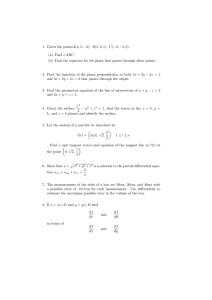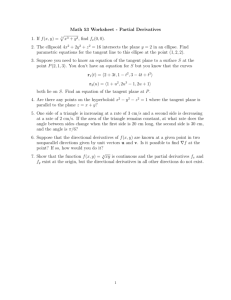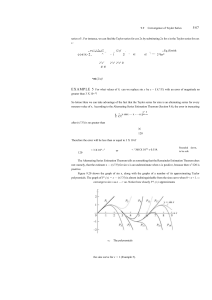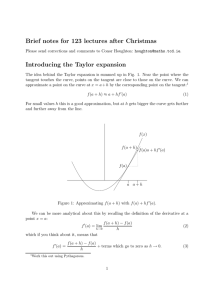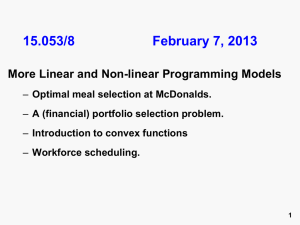Module MA1132 (Frolov), Advanced Calculus Homework Sheet 5
advertisement
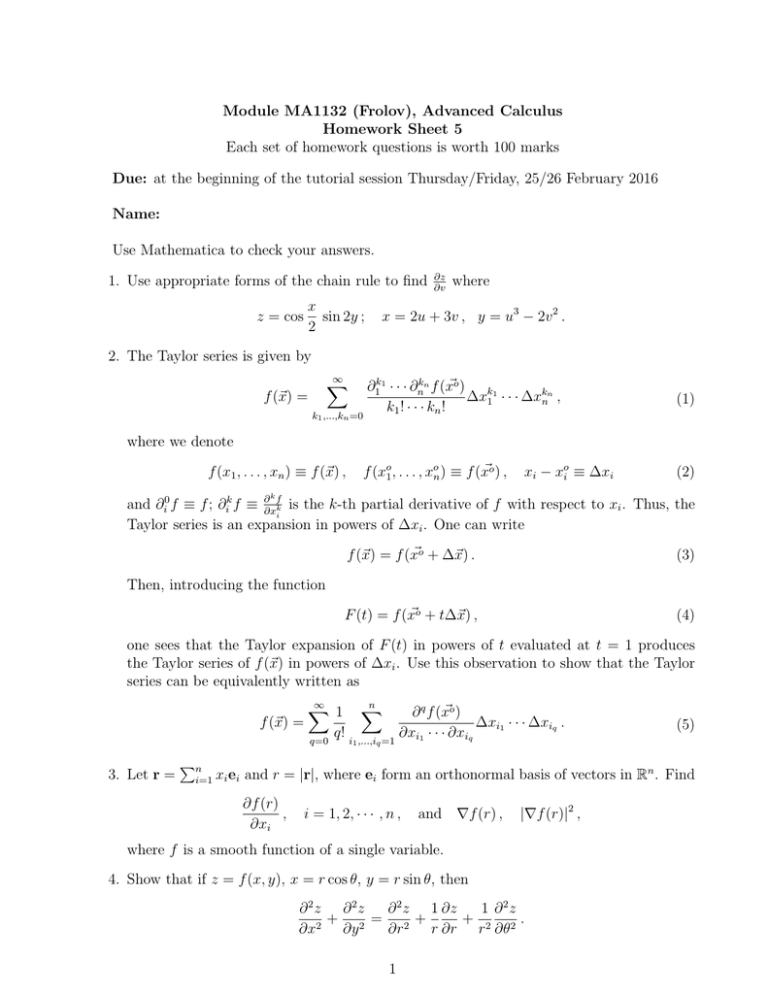
Module MA1132 (Frolov), Advanced Calculus Homework Sheet 5 Each set of homework questions is worth 100 marks Due: at the beginning of the tutorial session Thursday/Friday, 25/26 February 2016 Name: Use Mathematica to check your answers. 1. Use appropriate forms of the chain rule to find x sin 2y ; 2 z = cos ∂z ∂v where x = 2u + 3v , y = u3 − 2v 2 . 2. The Taylor series is given by ∞ X f (~x) = k1 ,...,kn ∂1k1 · · · ∂nkn f (x~o ) k1 ∆x1 · · · ∆xknn , k1 ! · · · kn ! =0 (1) where we denote f (xo1 , . . . , xon ) ≡ f (x~o ) , f (x1 , . . . , xn ) ≡ f (~x) , xi − xoi ≡ ∆xi (2) k and ∂i0 f ≡ f ; ∂ik f ≡ ∂∂xfk is the k-th partial derivative of f with respect to xi . Thus, the i Taylor series is an expansion in powers of ∆xi . One can write f (~x) = f (x~o + ∆~x) . (3) F (t) = f (x~o + t∆~x) , (4) Then, introducing the function one sees that the Taylor expansion of F (t) in powers of t evaluated at t = 1 produces the Taylor series of f (~x) in powers of ∆xi . Use this observation to show that the Taylor series can be equivalently written as f (~x) = n ∞ X ∂ q f (x~o ) 1 X ∆xi1 · · · ∆xiq . q! ∂x · · · ∂x i i q 1 q=0 i ,...,i =1 1 3. Let r = Pn i=1 (5) q xi ei and r = |r|, where ei form an orthonormal basis of vectors in Rn . Find ∂f (r) , ∂xi i = 1, 2, · · · , n , and ∇f (r) , |∇f (r)|2 , where f is a smooth function of a single variable. 4. Show that if z = f (x, y), x = r cos θ, y = r sin θ, then ∂ 2z ∂ 2z ∂ 2 z 1 ∂z 1 ∂ 2z + = 2+ + . ∂x2 ∂y 2 ∂r r ∂r r2 ∂θ2 1 5. Consider the surface z = f (x, y) = ln 1 2/3 p e 3 8x2 − 6xy 2 − y 3 + 32 − 12 sin(2x − y) 2 . (a) Find an equation for the tangent plane to the surface at the point P = (1, 2, z0 ) where z0 = f (1, 2). (b) Find points of intersection of the tangent plane with the x-, y- and z-axes. (c) Sketch the tangent plane, and show the point P = (1, 2, z0 ) on it. (d) Find parametric equations for the normal line to the surface at the point P = (1, 2, z0 ). (e) Sketch the normal line to the surface at the point P = (1, 2, z0 ). 6. Show that the equation of the plane that is tangent to the cone x2 y 2 z 2 + 2 − 2 =0 a2 b c at (x0 , y0 , z0 ) can be written in the form y0 z0 x0 x + 2y − 2z = 0. 2 a b c 7. Prove: If the surfaces z = f (x1 , . . . , xn ) and z = g(x1 , . . . , xn ) intersect at P = (xo1 , . . . , xon , z o ), and if f and g are differentiable at (xo1 , . . . , xon ), then the normal lines at P are perpendicular if and only if n X ∂f (xo , . . . , xo ) ∂g(xo , . . . , xo ) 1 i=1 n ∂xi 1 ∂xi 2 n = −1 .
